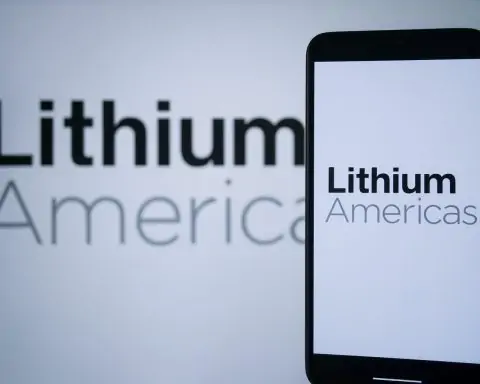Sydney – 18 November 2025
The Australian stock market suffered its worst day in months on Tuesday, with the S&P/ASX 200 tumbling nearly 2% as a global tech sell-off collided with a sharply more cautious Reserve Bank of Australia (RBA) and downbeat commentary from the Commonwealth Bank’s chief executive.
By the close, the S&P/ASX 200 had fallen 1.94% to around 8,469 points, its lowest level in almost five months. The broader All Ordinaries index dropped about 2% to roughly 8,738, wiping an estimated A$59–60 billion off the market’s value in a single session. [1]
Market strategists estimate the index has now shed about 7.3% since its late‑October peak near 9,115, erasing roughly A$220 billion in market capitalisation over the past four weeks. [2]
Key takeaways from today’s ASX session
- ASX 200 closed down 1.94% at ~8,469, touching intraday lows near 8,450 and hitting a five‑month low. [3]
- All 11 sectors finished in the red, with technology, materials and financials leading the decline. [4]
- Information Technology dropped around 3–6% on the day, leaving the tech index about 25% below its late‑September level. [5]
- RBA minutes signalled rates may stay on hold longer, with inflation expected to stay above the 2–3% target band into 2026. [6]
- CBA CEO Matt Comyn told parliament he does not expect a cash‑rate cut in 2026, reinforcing the hawkish shift in rate expectations. [7]
- A global tech rout, rising Japanese bond yields and a sharp fall in Bitcoin added to the “risk‑off” mood. [8]
ASX 200 sinks to five‑month low in broad-based sell-off
It was a one‑way day for Australian shares. The S&P/ASX 200 slid more than 2.1% at its worst point, trading near 8,450 before trimming losses slightly into the close. [9]
ABC’s live market blog reported that only 17 of the 200 index constituents finished higher, with 8 unchanged and 175 stocks closing in the red. Every major sector bar none ended lower, underlining just how widespread the selling pressure was. [10]
The session now ranks as the sharpest single‑day percentage fall since the heavy “Liberation Day” tariff‑related sell‑off earlier this year, according to local market commentary. [11]
Volatility also jumped: the S&P/ASX 200 VIX – a gauge of expected share‑price swings – surged nearly 17% to a six‑month high. [12]
From a technical perspective, the index sliced below its 200‑day moving average around 8,508, an important trend gauge for institutional traders. Analysts at IG noted that the ASX 200 is now at its most oversold on RSI momentum readings since the April “Liberation Day” low, underscoring how abrupt the reversal has been. [13]
Tech stocks “getting slaughtered” as AI trade unwinds
Technology shares once again sat at the eye of the storm.
- The S&P/ASX 200 Information Technology sector fell about 3.3% by the close, having been down more than 6% intraday, and is now roughly 25% below its late‑September level. [14]
- MarketIndex data show a long list of double‑digit declines across the tech complex, including Technology One, Catapult, Weebit Nano, SiteMinder, WiseTech Global, Xero, Life360, Nuix and NextDC. [15]
TechnologyOne (TNE) was the poster child of the rout. Despite posting a solid rise in annual profit, the enterprise software group missed market expectations on recurring revenue and declined to provide guidance for FY26. The result:
- The stock plunged around 17%, its worst day in more than two decades, according to Reuters and local coverage. [16]
Intraday commentary from Capital Brief and IG highlighted further carnage:
- Catapult Sports dropped about 9–10%.
- WiseTech Global and Xero lost roughly 4–5%.
- Defence‑tech player DroneShield slumped around 6–8%. [17]
This local slump is part of a global tech and AI de‑rating. An Associated Press report noted that Tokyo’s Nikkei 225 and Seoul’s Kospi both fell more than 3%, with chip and AI‑linked names leading the decline, as traders reassessed stretched valuations ahead of Nvidia’s closely watched earnings and delayed U.S. employment data. [18]
Banks and miners deepen the slide
The sell‑off was far from limited to tech.
Financials under pressure
The S&P/ASX 200 Financials index extended its losing streak, down about 1.4% at midday and staying weak into the close. [19]
Mid‑session snapshots showed:
- Macquarie Group down roughly 2.3%
- Westpac off about 2.3%
- Bank of Queensland down nearly 1.8%
- Commonwealth Bank (CBA) lower by 1.5–2.2%
- NAB and ANZ down a little over 1% each. [20]
IG’s afternoon note pointed out that CBA has now slipped more than 20% from its late‑June peak, leaving the country’s largest bank in “bear market” territory. [21]
Miners join the downturn
The materials sector also weighed heavily on the index:
- BHP fell just over 3%
- Rio Tinto slid around 2.5%
- Fortescue Metals Group dropped close to 1.8%. [22]
Capital Brief reported that the sector was down about 2.1% around lunchtime, even though iron ore prices were broadly stable near US$104 per tonne, suggesting the move was driven more by risk sentiment than commodity fundamentals. [23]
Few bright spots: James Hardie and lithium names shine
Against the sea of red, a handful of stocks managed robust gains.
James Hardie tops the leaderboard
James Hardie Industries (JHX) was the standout performer:
- The building materials group surged between 7–10%, depending on the intraday snapshot, after delivering second‑quarter earnings ahead of expectations and upgrading full‑year guidance. [24]
Investing.com data show JHX up nearly 9.9% at the close, making it the best performer in the ASX 200. [25]
Lithium rally continues
Lithium producers also bucked the trend:
- Pilbara Minerals climbed about 3.3%, reaching a fresh 52‑week high, according to Investing.com. [26]
- Liontown Resources gained roughly 3–4%.
- IGO advanced around 5% earlier in the day. [27]
IG linked the strength to rising lithium prices and renewed policy support for electric vehicles in China, which have rekindled investor appetite for battery‑materials plays. [28]
Other winners included GQG Partners, up about 3.6–6% on various intraday measures, and a cluster of defensive names in staples and healthcare, such as CSL, Coles and a2 Milk, which held up relatively well as money rotated toward lower‑volatility stocks. [29]
Hawkish RBA minutes and CBA’s outlook crush rate-cut hopes
Beyond the global tech wobble, domestic interest‑rate expectations were a major driver of today’s ASX sell‑off.
RBA minutes: inflation still too high, cuts only if growth weakens
The minutes from the RBA’s 4 November meeting, released today, confirmed that the central bank held the cash rate at 3.6% but struck a notably more cautious tone on further easing. [30]
Key messages from the minutes and accompanying analysis:
- Inflation is now expected to remain above the 2–3% target band until at least mid‑2026, before slowly drifting back toward the middle of the band later in the decade. [31]
- The Board stressed that additional cuts would only be considered if the labour market clearly weakens and capacity pressures ease, effectively narrowing the path for further easing. [32]
- Major banks have begun scrapping forecasts for extra rate cuts in 2025, and some analysts now warn the next move could even be a hike if inflation surprises again on the upside. [33]
CBA boss: “Unlikely” rates move before 2026 is over
Adding to the gloom, Commonwealth Bank CEO Matt Comyn told a parliamentary economics committee that he does not expect the cash rate to change for an extended period:
- Comyn said CBA’s economists believe the cash rate is likely to remain on hold “through 2026”, citing stronger‑than‑expected inflation and a still‑solid labour market. [34]
MarketIndex’s live coverage echoed those remarks, noting that Comyn told MPs he did not think a reduction in the cash rate was likely in 2026, a statement that landed just as tech and rate‑sensitive growth names were already on the back foot. [35]
For equity investors, this combination of hawkish RBA minutes and a sombre outlook from the head of the country’s largest lender effectively punctured hopes for a near‑term rate‑cut cycle – a key pillar underpinning the rally in high‑growth and heavily‑geared stocks earlier in the year. [36]
Global backdrop: tech rout, bond jitters and a “canary” in Bitcoin
Today’s slump on the ASX is part of a wider global risk‑off episode.
Asia and Wall Street under pressure
An Associated Press report highlighted that:
- Tokyo’s Nikkei 225 fell about 3%,
- South Korea’s Kospi dropped just over 3%,
- Hong Kong’s Hang Seng and China’s Shanghai Composite also weakened,
as investors reacted to steep declines in AI‑linked U.S. shares and rising long‑term Japanese bond yields. [37]
On Wall Street overnight:
- The S&P 500 fell roughly 0.9%,
- The Dow Jones lost about 1.2%,
- The Nasdaq composite slid around 0.8%,
with Nvidia and other AI leaders leading the pullback. [38]
Bond markets and Bitcoin send warning signs
IG and ABC both pointed to Japanese government bonds as an under‑appreciated trigger for today’s turmoil.
- 20‑year JGB yields have jumped to around 2.8%, the highest since the late 1990s, fuelling worries about global funding costs and valuations in high‑growth stocks. [39]
At home, Australian 10‑year yields fell about 4 basis points to around 4.44% as investors sought safety in sovereign debt, even as equity markets slumped. [40]
Meanwhile, Bitcoin’s slide below US$90,000 – down nearly 30% from its early‑October record – was described by IG’s Tony Sycamore as a “canary in the risk coalmine”, signalling broader stress across speculative assets. [41]
Australian dollar, commodities and cross‑asset moves
The Australian dollar spent most of the session hovering near a one‑week low around US$0.648, before recovering toward US$0.65 as traders digested the RBA’s more hawkish tone. [42]
Despite the equity rout, the moves in commodities were relatively orderly:
- Gold futures eased around 1–1.5%, to a little over US$4,000 an ounce. [43]
- Brent crude slipped about 0.6–0.7% to the US$63–64 a barrel range, extending a modest recent pullback. [44]
The fact that traditional safe‑havens such as gold were also sold, while volatility spiked, added to a sense that investors were raising cash across the board, rather than rotating neatly from risk assets into defensive ones. [45]
What investors are watching next
With the ASX 200 now sitting around June‑era lows and trading below key technical support, the big question is whether today’s move marks a capitulation low or merely another step in a deeper correction. [46]
Over the coming days, markets will be focused on:
- Nvidia’s earnings – seen as a bellwether for the global AI trade and high‑growth tech valuations. [47]
- The delayed U.S. employment report, which could reshape expectations for the Federal Reserve’s rate path and global risk appetite. [48]
- Australian data releases, including wage and inflation numbers, which will test the RBA’s baseline scenario that inflation remains above target into 2026. [49]
For now, local strategists broadly agree on three points:
- Rate‑cut hopes have been sharply repriced – the path of least resistance for policy is “higher for longer”, not fresh easing. [50]
- Valuations for richly‑priced tech and growth stocks are under renewed scrutiny, especially after a 25% drawdown in the tech index over two months. [51]
- Oversold conditions are building, and while that doesn’t guarantee a near‑term rebound, it does suggest that future macro surprises – positive or negative – could provoke outsized moves. [52]
How today’s move affects different types of investors
- Short‑term traders are likely to remain focused on volatility, sector rotation and macro catalysts (RBA commentary, Nvidia, U.S. data). High intraday ranges in tech, banks and lithium stocks present both opportunities and elevated risk. [53]
- Income‑focused investors in bank and utility shares will be watching for signs that the sell‑off stabilises as dividends and capital‑management programs come back into focus. [54]
- Long‑term growth investors face a tougher call: some high‑quality tech names are now trading 40–60% below prior peaks, but the combination of higher‑for‑longer rates and elevated global uncertainty means bottom‑fishing remains a high‑volatility strategy. [55]
For now, what’s clear is that 18 November 2025 will go down as one of the more bruising sessions of the year for the Australian share market, marking a decisive break lower in a correction that began in early November – and reminding investors that even in an AI‑driven bull market, gravity still applies.
References
1. www.abc.net.au, 2. www.ig.com, 3. www.abc.net.au, 4. www.abc.net.au, 5. www.marketindex.com.au, 6. www.rba.gov.au, 7. www.news.com.au, 8. www.whec.com, 9. www.washingtonpost.com, 10. www.abc.net.au, 11. www.abc.net.au, 12. www.investing.com, 13. www.ig.com, 14. www.abc.net.au, 15. www.marketindex.com.au, 16. www.abc.net.au, 17. www.capitalbrief.com, 18. www.whec.com, 19. www.marketindex.com.au, 20. www.marketindex.com.au, 21. www.ig.com, 22. www.ig.com, 23. www.capitalbrief.com, 24. www.ig.com, 25. www.investing.com, 26. www.investing.com, 27. www.marketindex.com.au, 28. www.ig.com, 29. www.mpcmarkets.com.au, 30. www.rba.gov.au, 31. www.marketscreener.com, 32. www.business-standard.com, 33. www.australianconveyancer.com.au, 34. www.news.com.au, 35. www.marketindex.com.au, 36. www.marketscreener.com, 37. www.whec.com, 38. www.washingtonpost.com, 39. www.ig.com, 40. www.abc.net.au, 41. www.abc.net.au, 42. www.business-standard.com, 43. www.abc.net.au, 44. www.abc.net.au, 45. www.theguardian.com, 46. www.mpcmarkets.com.au, 47. www.whec.com, 48. www.whec.com, 49. www.rba.gov.au, 50. www.marketscreener.com, 51. www.marketindex.com.au, 52. www.ig.com, 53. www.ig.com, 54. www.marketindex.com.au, 55. www.ig.com










